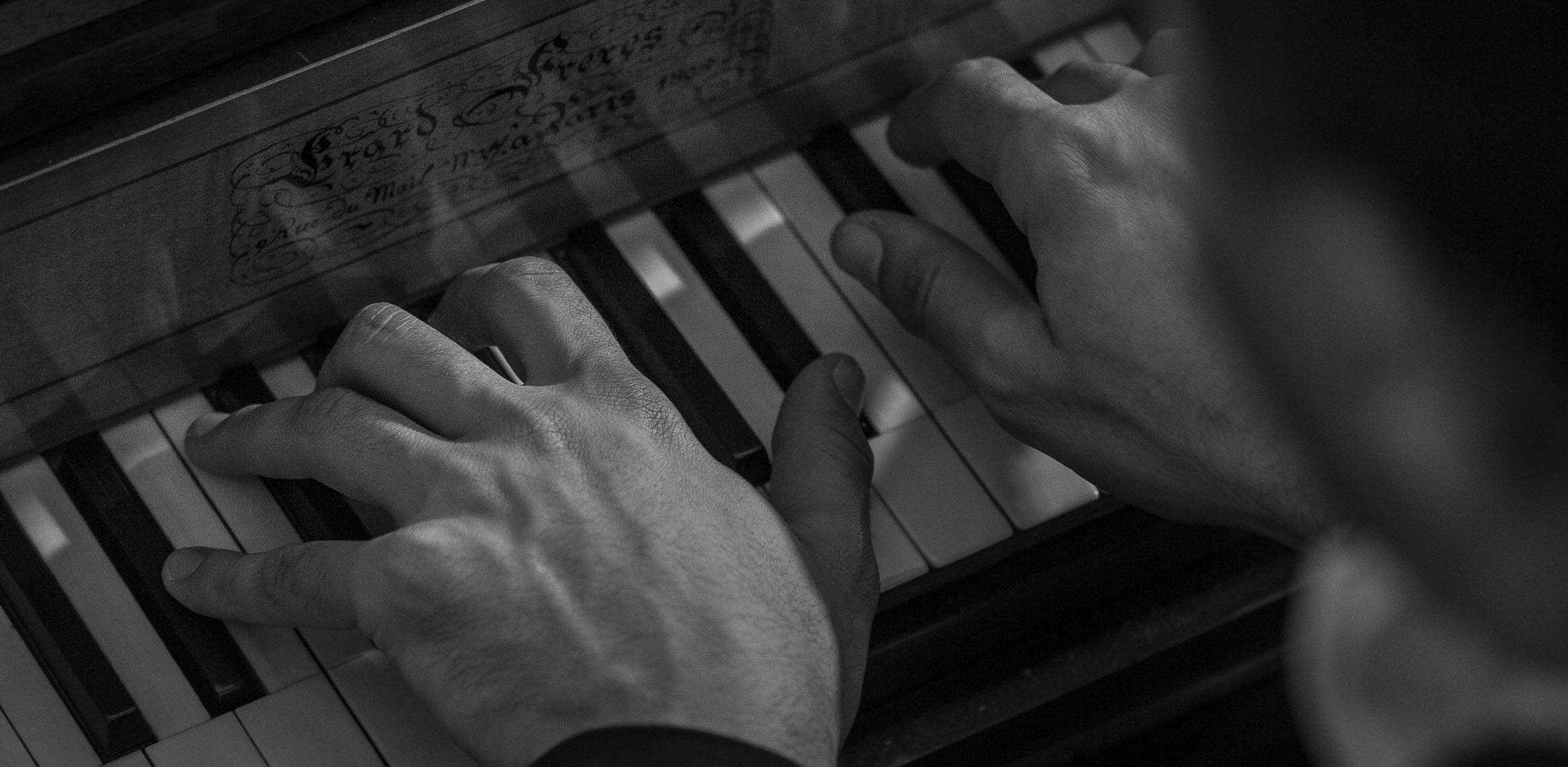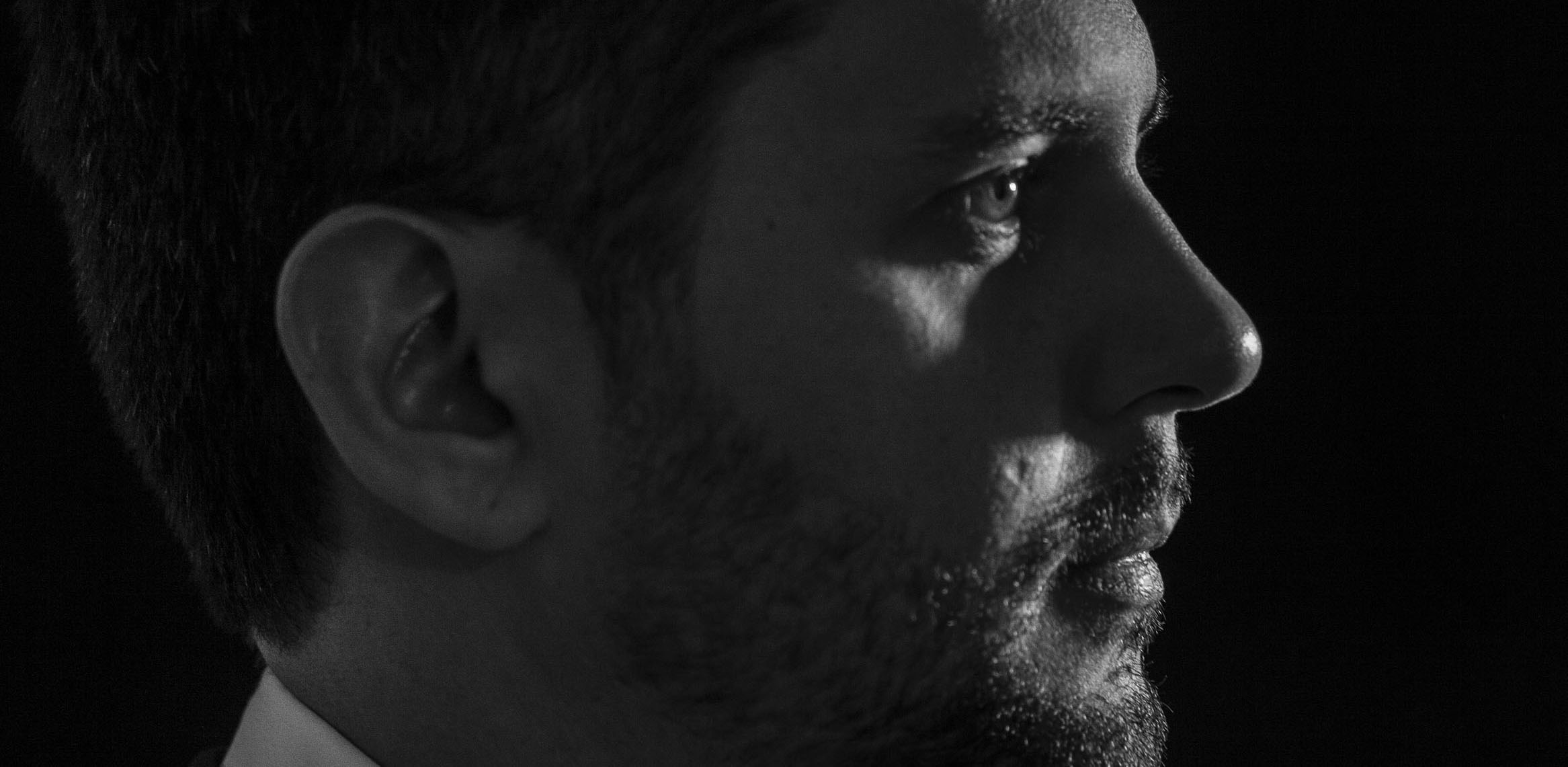

In September 2018, I had the opportunity to acquire an Érard & Frères square piano (Paris, 1805) built by Sébastien Érard (1752-1831). This maker of pianos, harps and harpsichords played a crucial role in the piano’s development in the 18th and 19th centuries. The instrument spans five octaves, with two strings per note, two pedals (damper and lute), and English action; it has a much smaller soundboard than those found in concert instruments, uses A-430 tuning, and offers the possibility of using various historical temperaments. It is an instrument, then, with very different timbres, effects and harmonic colors from those of contemporary pianos.
After acquiring it, I began artistic research, still in progress, experimenting with new interpretative approaches to composers including J.S. Bach (1685-1750), D. Scarlatti (1685-1757), C.P.E. Bach (1714-1788), F.J. Haydn (1732-1809), J.C. Bach (1735-1782), M. Clementi (1752-1832), W.A. Mozart (1756-1791) and L. van Beethoven (1770-1827), among others.
While fully immersed in this project, I had the opportunity to give a small concert series on this instrument, one of which was in Montserrat’s Santa Cecília church. For these concerts, I chose a programme that I had wanted to perform for years, ever since my undergraduate days: a work by F. J. Haydn which had been a very dear companion to me, which I admired with great devotion and which I had never missed in live performances (a woefully infrequent occurrence). And so I entered the world of The Seven Last Words of Christ.
The story of this work began in 1785, when the Confraternity of the Holy Cave of Cádiz commissioned Haydn to compose an orchestral work based on each of the seven last words or phrases spoken by Christ on the Cross, according to the Gospels. From a historico-liturgical perspective, the work corresponds to the spiritual practice called the “exercise of the three hours”, widespread in Spain from the mid-17th century. The practice consisted of a service that was held from 12 to 3pm on Good Friday. In this service, each of the seven last words of Christ were read, followed by a sermon and a piece of music that facilitated introspection and meditation on the text. It is believed that Haydn’s work was first performed on Good Friday in 1786, in Cádiz.
Currently, four versions of the work, published in the 18th century, are to be found: the original, for orchestra (catalogue Hob. XX: 1); one for string quartet, arranged by Haydn himself (Hob. XX/1B – opus 51), one for fortepiano, authorized by the composer (Hob. XX/1C) and, finally, the oratorio version written by Haydn ten years after the original and which premiered in Vienna in 1796. (Hob. XX: 2). The first three were published in 1787 by Artaria & Co., in Vienna, and the latter, in 1801, by Breitkopt & Härtel.
For this album, I have revisited the work, following the first edition for fortepiano. It contained certain errors and imprecisions which I have dealt with by comparing it with the manuscripts and first editions of the other three versions. I have modified and added many articulations in the musical text, corrected certain erroneous notes and harmonies and adapted certain passages that were different in the orchestral version, so as to achieve an effect that is more similar to that of the original. I have also made a transcription of the interlude between sonatas 4 and 5, written later on by Haydn. It appears in the oratorio version but has never been published or recorded in the piano versions.
This interpretation of The Seven Last Words of Christ is based on three principles that are key to understanding the work: adapting the musical text to the 1805 Érard & Frères square piano, capturing the introspective, meditative nature of the piece, as defined by Haydn himself, and directly applying an in-depth rhetorical analysis of the work.
Throughout my creative process, I constantly explored the range of effects that could be obtained given the technical and expressive possibilities offered by this instrument, while considering the demands of the work itself. Articulation took front seat: the gesturality of each note had to be made clear in relation to each following note. Legato phrasing was not an option, because the instrument does not allow it. Another important aspect was the conception of dynamics as the accumulation of resonance, not simply of volume. The clearest example is that of the “earthquake”, which seeks to simulate the natural phenomenon through accentuation and articulation (which favor rhythmic clarity) in combination with the damper pedal. A further effect involves the lute stop. Also found in some harpsichords, but not in modern pianos, this stop mimics the sound of its namesake. Since the work was originally written for orchestra, this stop was recruited for passages with pizzicato in the strings, to imitate their characteristic colour and texture.
The other two principles underpinning my interpretation - capturing its introspective character and applying a rhetorical analysis of the work - are explored in the following pages by Jesuit theologian Xavier Melloni in “Music as a way into the sacred” and by Dr. Rubén López-Cano in “Rhetorically informed interpretation: tempesta, ombra and Haydn”.
Haydn’s Seven Last Words of Christ is a work of infinite depth, both for the performer and for the audience. With this CD, I hope to open a door to this introspective journey towards understanding ourselves, with moments of doubt, shadow and storm, and others filled with light and affirmation.
Roger Illa Prats

At all times, and in all places, music has been a way of approaching the sacred. The sacred is that which overcomes us, opening us to something beyond our own selves. It is a borderline experience, and in art it is linked with the concept of the sublime.
The interpretation offered in this recording is inseparable from its liturgical origins: the Seven Last Words of Christ is a key element in the experience of Holy Week, and used to take place on the fifth Friday in Lent. It is interesting to consider the fact that, in the late 18th century, Haydn should receive a commission from Cádiz: this shows how much the ties of Old Europe still bound the continent. An Austrian immersed in the Austro-Hungarian court could not have failed to be impacted by the sobriety of the setting in which his work would be performed: Cádiz cathedral, entirely draped in black cloths, with a large lamp hanging from the ceiling, in a service lasting three hours in near total darkness.
Understanding all this is essential to understanding this work, especially when it is interpreted through the austerity of a piano keyboard. Without an understanding of the setting, we cannot approach the work. Similarly, to understand the work, we must approach the text at its genesis.
These are the words that Jesus spoke on the Cross, which come from different parts of the four Gospels. In the Cross, Christianity sees the universal human experience of pain, failure and death. Rather than glamorizing pain, the Cross offers a homeopathic cure: when humans contemplate the pain of the God-man, they can also embrace their own pain and give it meaning.
The Seven Words (actually seven phrases) blaze a path through the human experience of pain, transforming it.
1. The starting point is forgiveness, renouncing all resentment: “Father, forgive them; they do not know what they are doing.” (Luke 23:34). One can only approach death if one is reconciled.
2. “Today you will be with me in paradise” (Luke 23:43). Jesus says these words to the Penitent Thief, someone who shared the same fate as he, and, rather than complaining, felt compassion for Christ. This compassion opened the doors to heaven for him, since heaven is none other than the place of love.
3. “Woman, this is your son; son, this is your mother” (John 19:26-27). These words, spoken to Mary and the Beloved Disciple, show how, even on the cross, Jesus continues to care for others. His pain does not cause him to close himself up; it opens him to those around him. This shows the capacity for pain to engender compassion.
4. “My God, My God, why have you forsaken me?” (Matt. 27:46 and Mark 15:34). This is the nadir of despair. It occurs, neither at the end nor at the beginning, but in the middle, as a cry which was necessary for Jesus fully to experience his pain. Without truly experiencing it, he could not have transformed it.
5. “I am thirsty” (John 19:28). In all pain, there is a request for help, a desperate awareness of one’s own need. If we do not know how to express our needs, our confusion is all the greater. We cannot hope for others to interpret our own needs. It is essential to name them.
6. “It is fulfilled” (John 19:30). It is vital to live through each stage of our experience. Only when we have fully lived what we need to live, and learned what we need to learn, can we move on.
7. “Father, into your hands I commit my spirit” (Luke 23:46). At the end comes full surrender. We humans become complete when we are able to trust and surrender to a Presence greater than ourselves, one that sustains us even when we are not aware of it. Jesus felt such a bond with God throughout his whole life; this is why he calls him “Father”.
The final movement, interpreted with vigor, expresses the finalization of the cycle. Come what may, it must start over again. After the earthquake, nothing more remains than silence. Only in this way can the unprecedented emerge.
Roger Illa’s masterful interpretation bears the marks of his personal investment in the work, both in his choice of this piece and in the way he has recreated it. Haydn’s Seven Last Words was born from contemplation and calls us to contemplate. In Illa’s hands, each note expresses the richness of the nuances condensed in these Words. He gifts us with music that soothes the pain that all of us all carry inside.
Javier Melloni Ribas

Various treatises from the 17th and 18th centuries adopted terminology from rhetoric and applied it to the study of music, treating music as a type of persuasive discourse. 20th-century musicology reconstructed a few of these principles, such as the genesis of argumentative ideas (inventio), their organization to appear in the most effective moment (dispositio) and, naturally, those special moments of eloquence where the rules of grammar go by the wayside to make room for eccentric, elegant, deeply compelling turns of phrase called rhetorical figures (decoratio). However, theorists scarcely touched on pronuntiatio: the performance principles for speakers. Uncovering the secrets of this domain was the task of great musicians like Nikolaus Harnoncourt, who demonstrated the importance of rhetoric in understanding and performing music from before the 19th century. In a more systematic way, the generation of Philippe Herreweghe and Jos van Immerseel experimented and applied rhetoric to musical performance, and also reflected publicly on the topic.
But what does performing music rhetorically mean? Musicologist Nicholas Cook generically refers to the performance styles from before the appearance of the phonograph as rhetorical performance. At that time, music consisted of ephemeral performances that vanished after the moment they were given. Performers’ readings of their scores were more flexible: they sacrificed accuracy and precision for broad, impulsive, ever contrasting gestures. Musicians adjusted tempos (agogics), phrasing and articulation in the service of a hyperbolized expressivity. Early recordings of pianists and singers attest to this. When phonographic records became widespread, and each performance became a stable document that could be consulted or listened to over and again, performance practice changed drastically and became more detailed, measured, stable and, as a result, predictable.
Here, however, we are discussing what Rafael Palacios calls hetorically informed performance: meticulously applying principles from the old musical rhetoric in making interpretative decisions on the instrument. The current generation, which includes fortepianists like Bart van Oort and Tom Beghin, is developing forms of musical elocution rooted in the vast spectrum of musical declamation, or to use Cook’s words, the infinite possibilities of spoken melodies and sung speeches.
Their interpretative choices are clearly inspired by an array of declamatory techniques for poetry, prose, elegies and odes, as well as emphatic elocution used by actors, strategies that are unpredictable and always surprising. Each piece of music is treated as a small drama, a story without words whose objective is to use rhetorical persuasion to move us profoundly. The vocal, dramatic origins of Haydn’s Seven Last Words of Christ for solo piano (1787) make it an ideal piece for this kind of treatment. In this recording, Roger Illa makes these interpretative modalities his own.
As is plain to hear, Illa’s interpretation is characterised by a prosodic treatment of agogic accents. Rests are not simply the absence of sound: in his hands, they become an intense means of expression, filled with emotions that cannot be expressed in any other way. Beautiful, proportionately sculpted melodic lines are sacrificed on the altar of expressive fragmentation, spontaneous accents, sudden diminuendi and rubati that convey uncertainty and doubt. They guide us into uncertain labyrinths and leave us in uneasy suspense, until the next exclamation or dissonance startles us and confronts us with our own fears, fantasies, guilt and cherished hopes.
The expressive register of the work moves between ombra and tempesta, styles which were erroneously encapsulated in the term Sturm und Drang until a few years ago. These two musical archetypes appeared in the first operas of the 17th century, and soon permeated instrumental music; Haydn was a true master of them. Ombra refers to mysterious scenes in which oracles or magicians pondered the future before pronouncing prophecies. In tempesta, on the other hand, the forces of nature are violently unleashed. Winds howl, waters rage, lightning bolts and claps of thunder fill the sky and beasts on land and sea charge and stampede. Both registers explore the terror inherent in the aesthetics of the sublime - that which transcends all human proportions. Each note in this exquisite recording convinces us of this.
Rubén López Cano
